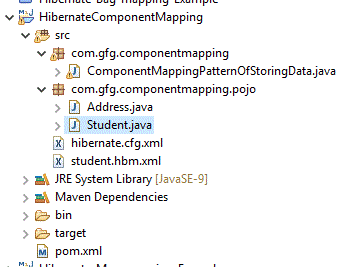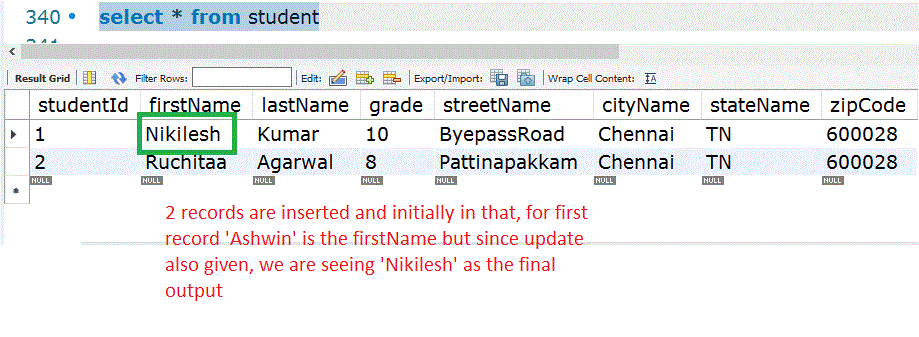En general, un estudiante puede tener una dirección/un empleado puede tener una dirección. Para este tipo de requisitos, podemos seguir el mapeo de componentes . No es más que una clase que tiene una referencia a otra clase como variable miembro. es decir, dentro de la clase ‘estudiante’, podemos tener la clase ‘dirección’ como una variable miembro. En MySQL basta con una única tabla que contenga la información de todos los atributos de ambas clases. Aquí, en nuestro ejemplo, podemos ver ‘estudiante’ como clase principal y tiene ‘dirección’ como variable miembro.
Proyecto de ejemplo
Estructura del proyecto:

Estructura de la tabla MySQL para Estudiante:
-- Student table create table Student( studentId INT NOT NULL auto_increment, firstName VARCHAR(20) default NULL, lastName VARCHAR(20) default NULL, grade INT default NULL, streetName VARCHAR(40) default NULL, -- Belongs to Address class cityName VARCHAR(40) default NULL, -- Belongs to Address class stateName VARCHAR(40) default NULL, -- Belongs to Address class zipCode VARCHAR(10) default NULL, -- Belongs to Address class PRIMARY KEY (studentId) );
Es suficiente si tenemos solo 1 tabla y debe tener todos los campos especificados en la segunda clase. Aquí nuestra primera clase es ‘Estudiante’ y la segunda clase es ‘Dirección’. Veamos las clases de POJO
Estudiante.java
Java
public class Student {
// It is always good to go with each attribute of MySQL
// table
private int studentId;
private String firstName;
private String lastName;
private int grade;
// Attributes that are available in 'Address' class. By
// referring here, we can access them. As Component
// Mapping is used, it is possible
private Address address;
// As address itself is set as an attribute in student
// class,
// all the address related arguments can be passed
// easily via set method
public Address getAddress() { return address; }
public void setAddress(Address address)
{
this.address = address;
}
public int getStudentId() { return studentId; }
public void setStudentId(int studentId)
{
this.studentId = studentId;
}
public String getFirstName() { return firstName; }
public void setFirstName(String firstName)
{
this.firstName = firstName;
}
public String getLastName() { return lastName; }
public void setLastName(String lastName)
{
this.lastName = lastName;
}
public int getGrade() { return grade; }
public void setGrade(int grade) { this.grade = grade; }
public Student(String firstName, String lastName,
int grade, Address address)
{
this.firstName = firstName;
this.lastName = lastName;
this.grade = grade;
this.address = address;
}
public Student() {}
}
Dirección.java
Java
public class Address extends Student {
private String streetName;
private String cityName;
private String stateName;
private String zipCode;
public Address() {}
// We should have this constructor so that address
// parameters
// can be set easily and can be accessed in student
// class
public Address(String street, String city, String state,
String zipcode)
{
this.streetName = street;
this.cityName = city;
this.stateName = state;
this.zipCode = zipcode;
}
public String getStreetName() { return streetName; }
public void setStreetName(String streetName)
{
this.streetName = streetName;
}
public String getCityName() { return cityName; }
public void setCityName(String cityName)
{
this.cityName = cityName;
}
public String getStateName() { return stateName; }
public void setStateName(String stateName)
{
this.stateName = stateName;
}
public String getZipCode() { return zipCode; }
public void setZipCode(String zipCode)
{
this.zipCode = zipCode;
}
}
Este proyecto es un proyecto impulsado por maven. Por lo tanto, comencemos con pom.xml
pom.xml
XML
<project xmlns="http://maven.apache.org/POM/4.0.0" xmlns:xsi="http://www.w3.org/2001/XMLSchema-instance" xsi:schemaLocation="http://maven.apache.org/POM/4.0.0 https://maven.apache.org/xsd/maven-4.0.0.xsd"> <modelVersion>4.0.0</modelVersion> <groupId>HibernateComponentMapping</groupId> <artifactId>HibernateComponentMapping</artifactId> <version>0.0.1-SNAPSHOT</version> <build> <sourceDirectory>src</sourceDirectory> <resources> <resource> <directory>src</directory> <excludes> <exclude>**/*.java</exclude> </excludes> </resource> </resources> <plugins> <plugin> <artifactId>maven-compiler-plugin</artifactId> <version>3.8.1</version> <configuration> <release>9</release> </configuration> </plugin> </plugins> </build> <dependencies> <dependency> <groupId>org.hibernate</groupId> <artifactId>hibernate-core</artifactId> <version>5.4.15.Final</version> </dependency> <!-- As we are connecting with MySQL, this is needed --> <dependency> <groupId>mysql</groupId> <artifactId>mysql-connector-java</artifactId> <version>5.1.34</version> </dependency> </dependencies> <properties> <maven.compiler.source>1.8</maven.compiler.source> <maven.compiler.target>1.8</maven.compiler.target> </properties> </project>
Para hibernate, hibernate.cfg.xml es el archivo de configuración principal
hibernate.cfg.xml
XML
<?xml version='1.0' encoding='UTF-8'?> <!DOCTYPE hibernate-configuration PUBLIC "-//Hibernate/Hibernate Configuration DTD 3.0//EN" "http://hibernate.sourceforge.net/hibernate-configuration-3.0.dtd"> <hibernate-configuration> <session-factory> <!-- As we are connecting mysql, those driver classes, database name, username and password are specified Please change the information as per your requirement --> <property name="hbm2ddl.auto">update</property> <property name="connection.driver_class">com.mysql.jdbc.Driver</property> <property name="connection.url">jdbc:mysql://localhost:3306/geeksforgeeks?serverTimezone=UTC</property> <property name="connection.username">root</property> <property name="connection.password">admin</property> <!-- We are going to connect student.hbm.xml which has the table information about student which is present in mysql --> <mapping resource="student.hbm.xml" /> </session-factory> </hibernate-configuration>
Nuestro recurso de mapeo es student.hbm.xml.
estudiante.hbm.xml
XML
<?xml version='1.0' encoding='UTF-8'?> <!DOCTYPE hibernate-mapping PUBLIC "-//Hibernate/Hibernate Mapping DTD 5.3//EN" "http://hibernate.sourceforge.net/hibernate-mapping-3.0.dtd"> <hibernate-mapping> <!-- The <class> elements denotes specific mappings from a Java classes to the database tables. The Java class name is given at the name attribute database table name is given using the table attribute.--> <class name="com.gfg.componentmapping.pojo.Student" table="Student"> <!-- Details about the enclosed class --> <meta attribute = "class-description"> This class contains the student detail. </meta> <!-- Unique ID to the Primary Key of the database table --> <id name = "studentId" type = "int" column = "studentId"> <generator class="native"/> </id> <!-- The <component> element can help to bring about different attributes of Address class inside Student classes. --> <component name = "address" class="com.gfg.componentmapping.pojo.Address"> <property name = "streetName" column = "streetName" type = "string"/> <property name = "cityName" column = "cityName" type = "string"/> <property name = "stateName" column = "stateName" type = "string"/> <property name = "zipCode" column = "zipCode" type = "string"/> </component> <property name = "firstName" column = "firstName" type = "string"/> <property name = "lastName" column = "lastName" type = "string"/> <property name = "grade" column = "grade" type = "int"/> </class> </hibernate-mapping>
Ahora veamos la clase principal donde podemos hacer una operación CRUD normal. Veamos los pasos de adición y actualización de un alumno en este ejemplo.
ComponentMappingPatternOfStoringData.java
Java
import com.gfg.componentmapping.pojo.Address;
import com.gfg.componentmapping.pojo.Student;
import java.util.Iterator;
import java.util.List;
import org.hibernate.HibernateException;
import org.hibernate.Session;
import org.hibernate.SessionFactory;
import org.hibernate.Transaction;
import org.hibernate.cfg.Configuration;
public class ComponentMappingPatternOfStoringData {
private static SessionFactory factory;
public static void main(String[] args)
{
try {
factory = new Configuration()
.configure()
.buildSessionFactory();
}
catch (Throwable ex) {
System.err.println(
"Failed to create sessionFactory object."
+ ex);
throw new ExceptionInInitializerError(ex);
}
ComponentMappingPatternOfStoringData
componentMappingExample
= new ComponentMappingPatternOfStoringData();
// Address1
Address address1
= componentMappingExample.addAddress(
"ByepassRoad", "Chennai", "TN", "600028");
// Add student records in the database
Integer studentId
= componentMappingExample.addStudent(
"Ashwin", "Kumar", 10, address1);
// Address2
Address address2
= componentMappingExample.addAddress(
"Pattinapakkam", "Chennai", "TN", "600028");
// Add another student record in the database
Integer student2
= componentMappingExample.addStudent(
"Ruchitaa", "Agarwal", 8, address2);
// List down all the students
componentMappingExample.listStudents();
// Update student's name as a sampple
componentMappingExample.updateStudent(studentId,
"Nikilesh");
// List down all the students. We can see the
// updated value for the first student
componentMappingExample.listStudents();
}
// Method to add an address record in the database
public Address addAddress(String street, String city,
String state, String zipcode)
{
Session session = factory.openSession();
Transaction tx = null;
Integer addressID = null;
Address address = null;
try {
tx = session.beginTransaction();
address
= new Address(street, city, state, zipcode);
addressID = (Integer)session.save(address);
tx.commit();
}
catch (HibernateException e) {
if (tx != null)
tx.rollback();
e.printStackTrace();
}
finally {
session.close();
}
return address;
}
// Method to add a student record in the database
public Integer addStudent(String fname, String lname,
int salary, Address address)
{
Session session = factory.openSession();
Transaction tx = null;
Integer studentID = null;
try {
tx = session.beginTransaction();
// By using Student constructor, we can see the
// fields
Student student = new Student(fname, lname,
salary, address);
studentID = (Integer)session.save(student);
tx.commit();
}
catch (HibernateException e) {
if (tx != null)
tx.rollback();
e.printStackTrace();
}
finally {
session.close();
}
return employeeID;
}
// Method to list all the student detail
public void listStudents()
{
Session session = factory.openSession();
Transaction tx = null;
try {
tx = session.beginTransaction();
// Take the data from Student table
List students
= session.createQuery("FROM Student")
.list();
// Iterate the details and display them
for (Iterator iterator = students.iterator();
iterator.hasNext();) {
Student student = (Student)iterator.next();
System.out.print("First Name: "
+ student.getFirstName());
System.out.print(" Last Name: "
+ student.getLastName());
System.out.println(" Grade: "
+ student.getGrade());
Address add = student.getAddress();
System.out.println("Address ");
System.out.println("\tStreet: "
+ add.getStreetName());
System.out.println("\tCity: "
+ add.getCityName());
System.out.println("\tState: "
+ add.getStateName());
System.out.println("\tZipcode: "
+ add.getZipCode());
}
tx.commit();
}
catch (HibernateException e) {
if (tx != null)
tx.rollback();
e.printStackTrace();
}
finally {
session.close();
}
}
// Method to update name for a given student
public void updateStudent(Integer studentId,
String firstName)
{
Session session = factory.openSession();
Transaction tx = null;
try {
tx = session.beginTransaction();
Student student = (Student)session.get(
Student.class, studentId);
student.setFirstName(firstName);
session.update(student);
tx.commit();
}
catch (HibernateException e) {
if (tx != null)
tx.rollback();
e.printStackTrace();
}
finally {
session.close();
}
}
}
Al ejecutar el proyecto, podemos ver el siguiente resultado.
Producción:

La salida de MySQL también coincide con la misma

Conclusión
Al usar el mapeo de componentes, la asociación de elementos de clase se puede hacer fácilmente y en MySQL, es suficiente si tenemos una sola tabla solo para satisfacer el mapeo de componentes.
Publicación traducida automáticamente
Artículo escrito por priyarajtt y traducido por Barcelona Geeks. The original can be accessed here. Licence: CCBY-SA